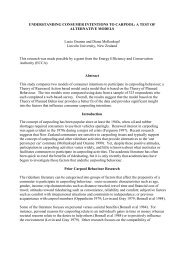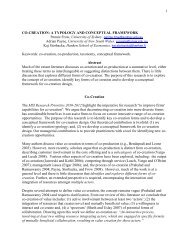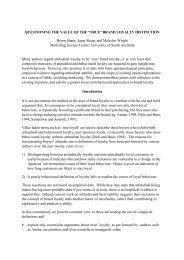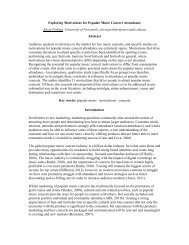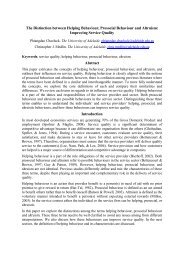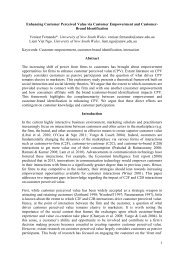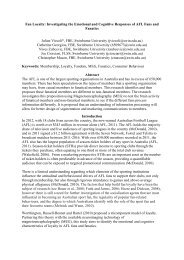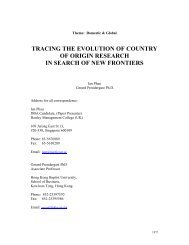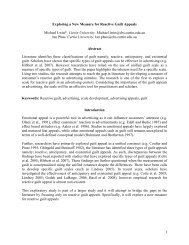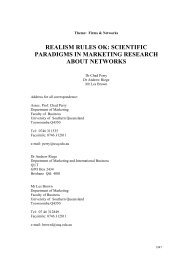1 A Study of Logo Form, Tone and Attribute Preferences ... - ANZMAC
1 A Study of Logo Form, Tone and Attribute Preferences ... - ANZMAC
1 A Study of Logo Form, Tone and Attribute Preferences ... - ANZMAC
You also want an ePaper? Increase the reach of your titles
YUMPU automatically turns print PDFs into web optimized ePapers that Google loves.
A <strong>Study</strong> <strong>of</strong> <strong>Logo</strong> <strong>Form</strong>, <strong>Tone</strong> <strong>and</strong> <strong>Attribute</strong> <strong>Preferences</strong> Across Stakeholder Groups by<br />
an Employment Agency Sourcing Jobs for People with Disabilities.<br />
M. S. Yousuf *. University <strong>of</strong> South Australia. mohamad.yousuf@unisa.edu.au<br />
Dr. Elizabeth Hemphill. University <strong>of</strong> South Australia. elizabeth.hemphill@unisa.edu.au<br />
Keywords: logo, form, tone, br<strong>and</strong>, identity, stakeholders, disability, agency, jobs.<br />
Abstract<br />
This research examines a practitioner’s approach to logo redevelopment striving for appeal<br />
consistency across stakeholder groups. A specialist employment agency (Finding Workable<br />
Solutions) facing difficulties communicating a consistently positive image to local business<br />
owners, clients (people with disabilities seeking work), internal staff <strong>and</strong> other stakeholders<br />
donated online survey data for analysis. 223 participants selected their preferred logo form<br />
<strong>and</strong> tone from three logo designs <strong>and</strong> rated other logo attributes such modern <strong>and</strong> pr<strong>of</strong>essional<br />
using Likert scales. Data contained Staff (24%), Clients (18%), Local Business Owners (8%),<br />
Staff <strong>of</strong> Local Organisations (13%), Staff <strong>of</strong> Other Organisations (22%) <strong>and</strong> Other (15%).<br />
Analysis revealed all stakeholder groups preferred the same logo form <strong>and</strong> tone suggesting<br />
consultative logo redevelopment to be an useful method <strong>of</strong> achieving consistent stakeholder<br />
group appeal. However, Local Business Owners exhibiting more rational attitudes than other<br />
stakeholders groups warrant targeted strategies to manage interpretation <strong>and</strong> meaning <strong>of</strong> logo<br />
attributes.<br />
Introduction<br />
Corporate identity helps a company to st<strong>and</strong> out from others <strong>and</strong> is therefore strategically very<br />
important as a central, distinctive <strong>and</strong> enduring feature <strong>of</strong> an organisation (Whetten &<br />
Godfrey, 1998). Organisations transmit these features through visual identity elements like<br />
buildings, products, uniforms, staff, paperwork <strong>and</strong> the logo (Hynes, 2009). A corporate logo<br />
is considered to be the most efficient tool to communicate desired values with stakeholders<br />
(Van Riel & Van den Ban, 2001). The rationale behind this is that pictures are perceived<br />
faster than words (Edell & Staelin, 1983).<br />
Corporate br<strong>and</strong>ing involves multiple stakeholders, including employees, investors, suppliers,<br />
regulators <strong>and</strong> local communities in addition to customers (Hatch & Schultz, 2003). A strong<br />
corporate br<strong>and</strong> will communicate a corporation’s mission <strong>and</strong> philosophies to each<br />
stakeholder clearly (Balmer, 1998). Within a br<strong>and</strong>, a logo should readily evoke a similar<br />
meaning among stakeholders <strong>of</strong> the organisation (Durgee & Stuart, 1987; Kropp, French, &<br />
Hillard, 1990; Vartorella, 1990). Without this consistency corporations are at risk <strong>of</strong><br />
misinterpretation (Keller, 1993) among stakeholders, which may in turn evoke negativity <strong>and</strong><br />
harm the corporate image (Bird, 1992). Strategic attention should therefore be paid to<br />
corporate logo design elements, particularly shape <strong>and</strong> color (Hynes, 2009), as these serve as<br />
a signature <strong>of</strong> a company (Snyder, 1993).<br />
A stakeholder is any individual or group affected by an organisation or affecting an<br />
organisation’s achievement <strong>of</strong> its objectives (Freeman, 2010). Stakeholders interact, cooperate<br />
<strong>and</strong>/or compete for resources (Neville <strong>and</strong> Menguc, 2006; Freeman, 2010). For example,<br />
internal stakeholders <strong>of</strong> employment agencies, e.g., staff, <strong>and</strong> external stakeholders, e.g.,<br />
people looking for jobs <strong>and</strong> employers that have job vacancies, have different needs <strong>of</strong> an<br />
1
employment agency <strong>and</strong> may therefore value differently attributes <strong>of</strong> the agency br<strong>and</strong>. This<br />
study examines the case <strong>of</strong> one employment agency whose employees find jobs in local<br />
organisations for unemployed people with disabilities (PWDs). This agency embarked on a<br />
br<strong>and</strong> ‘refresh’ because staff experienced difficulties explaining to PWDs <strong>and</strong> local employers<br />
what the existing logo was meant to represent <strong>and</strong> what the organisation did.<br />
Unemployed PWDs facing social isolation (Teasdale 2010, p. 94) <strong>and</strong> declining employment<br />
opportunities (McVicar 2006, p. 520) are supported in their job search (Luecking, 2008;<br />
Olney & Lyle, 2011) by specialist employment agencies (SEA). Local employer reluctance<br />
to employ PWDs (Hergenrather, Turner, Rhodes & Barlow, 2008) can lead to PWDs<br />
becoming frustrated with job searching. SEAs need all the help they can get to communicate<br />
positive messages to these stakeholders about what they do. A consultative approach to logo<br />
development could achieve a logo design that holds a consistent appeal to all key stakeholders<br />
<strong>and</strong> communicates consistent messages about the br<strong>and</strong> to all stakeholders. This paper reports<br />
one SEA’s experience <strong>of</strong> consultative logo redesign across stakeholder groups in the<br />
community it serves to determine the merit <strong>of</strong> such an approach for practitioners.<br />
Background <strong>and</strong> Literature<br />
Corporate logos are the graphic design elements that a company uses, with or without its<br />
name, to identify itself or its products (Bennet 1995; Giberson & Hull<strong>and</strong> 1994). A logo<br />
captures the essence <strong>of</strong> the company’s philosophy <strong>and</strong> product’s main attributes in a single<br />
symbol (Muzellec, Doogan & Lambkin, 2003). Companies tend to use a logo as a means to<br />
communicate with both internal <strong>and</strong> external stakeholders (Zakia & Nadin, 1987). Thus, logo<br />
selection is a critical vehicle for an organisation to communicate its image, help gain attention<br />
in the clutter <strong>of</strong> br<strong>and</strong>s <strong>and</strong> speed the recognition process <strong>of</strong> the company <strong>and</strong> its <strong>of</strong>ferings<br />
(Henderson & Cote, 1998).<br />
More recently, br<strong>and</strong> identity research reveals non-br<strong>and</strong> name elements like logo color <strong>and</strong><br />
form to act as distinctive assets <strong>of</strong> a br<strong>and</strong> (Romaniuk & Hartnett, 2010) that evoke a br<strong>and</strong><br />
name in the memory <strong>of</strong> the customer <strong>and</strong> help to identify a br<strong>and</strong> in a buying situation.<br />
Distinctive assets are about identifying a br<strong>and</strong> rather than unique selling propositions. When<br />
an element <strong>of</strong> a br<strong>and</strong> becomes a distinctive asset, it makes it easier for consumers to notice,<br />
recognise, recall <strong>and</strong> buy the br<strong>and</strong> (Sharp, 2010). Highly unique <strong>and</strong> prevalent colors are<br />
particularly useful as distinctive assets (Romaniuk & Nenycz-Thiel, 2012). The distinctive<br />
nature <strong>and</strong> value <strong>of</strong> br<strong>and</strong> elements are critically important to retail consumer buying<br />
decisions (e.g., supermarkets) (Yang & Raghubir, 2005) <strong>and</strong> in targeted advertising <strong>and</strong><br />
market communication activities (Romaniuk, Sharp & Ehrenberg, 2007). Therefore, logo<br />
design should consider uniqueness <strong>and</strong> prevalence <strong>of</strong> both color <strong>and</strong> form to help potential<br />
customers identify <strong>and</strong> remember the br<strong>and</strong> in a buying situation.<br />
A good logo is recognisable, familiar <strong>and</strong> produce a consensually held meaning in the target<br />
market (Durgee & Stuart, 1987; Kropp et al., 1990; Peter, 1989; Vartorella, 1990) by using<br />
appropriate stimuli that conveys a clear message <strong>and</strong> avoids misinterpretation (Keller, 1993).<br />
Semiotics literature recommends that the meaning <strong>of</strong> the stimulus can be assessed by<br />
examining the core or consensual meaning it evokes (Perussia, 1988). Underst<strong>and</strong>ing the<br />
suitability <strong>of</strong> a logo among various stakeholders requires examination <strong>of</strong> the evoked meaning<br />
<strong>of</strong> the stimulus associated with the logo color, shape <strong>and</strong> font.<br />
General guidelines in the br<strong>and</strong>ing literature suggest logos to transmit both functional (e.g.,<br />
2
pr<strong>of</strong>essiional,<br />
frienddly)<br />
<strong>and</strong> emmotional<br />
(ee.g.,<br />
modernn,<br />
sleek) be enefits <strong>of</strong> tthe<br />
companny<br />
to all<br />
kinds <strong>of</strong>f<br />
stakeholdeers<br />
(Mitcheell,<br />
2003; Br<strong>and</strong>t<br />
& Johhnson,<br />
1997 7). Further, familiarityy<br />
<strong>and</strong> the<br />
evoked meaning <strong>of</strong><br />
logo desiggn<br />
(both coolor<br />
<strong>and</strong> forrm)<br />
are imp portant logoo<br />
attributes (Hynes,<br />
2009). L<strong>Logo</strong>s<br />
unde ergo re-deveelopment<br />
frrom<br />
time too<br />
time for mmany<br />
reason ns such as mmergers,<br />
acquisittions,<br />
divesttitures<br />
<strong>and</strong> movement in the globbal<br />
markets s (Siegel, 1989;<br />
Spaethh,<br />
1994;<br />
Wathenn,<br />
1986), ne ew productss,<br />
new brannds<br />
(Siegel, , 1989), packaging<br />
chhanges<br />
(Morrgenson,<br />
1992), tto<br />
improve competitivveness<br />
(Hors sky & Swyyngedouw,<br />
1987) <strong>and</strong> to t appear frresh<br />
<strong>and</strong><br />
modern n (Morgan, 1986; Moorgenson,<br />
1992; Sieggel,<br />
1989). Strategic managemeent<br />
<strong>of</strong> a<br />
corporaate<br />
logo is th herefore crittical<br />
to an ooverall<br />
br<strong>and</strong>d<br />
strategy.<br />
Corporaate<br />
br<strong>and</strong>ing<br />
strategy success lar rgely depennds<br />
on mee eting specif fic requiremments<br />
<strong>of</strong><br />
multiplee<br />
stakehold ders includinng<br />
employe ees, supplieers<br />
<strong>and</strong> loca al communnities<br />
in adddition<br />
to<br />
customeers<br />
(Hatch a<strong>and</strong><br />
Shultz, 2003). We expect thatt<br />
a logo ma ay not transmmit<br />
the samme<br />
image<br />
across stakeholder r groups soo<br />
we inves stigate twoo<br />
research questions. Are stakkeholder<br />
prefereences<br />
for loogo<br />
form coonsistent<br />
aacross<br />
stakeeholder<br />
gro oups? Andd,<br />
are stakkeholder<br />
prefereences<br />
for logo<br />
color tone<br />
consisteent<br />
across sstakeholderr<br />
groups?<br />
Method<br />
We adoopt<br />
a case sstudy<br />
(e.g., Woodside, 2010) appproach<br />
to ex<br />
confinedd<br />
set <strong>of</strong> loggo<br />
form <strong>and</strong>d<br />
tone choic ces. For praactical<br />
purp<br />
the studdy.<br />
For theeoretical<br />
purrposes<br />
largee<br />
scale quaantitative<br />
stu<br />
stakeholder<br />
groupss<br />
would be required to o establish aany<br />
boundar<br />
We seleected<br />
Findinng<br />
Workablle<br />
Solutions s Inc. (FWSS;<br />
www.fws<br />
a big brr<strong>and</strong><br />
it com mpetes with the other big<br />
br<strong>and</strong> inn<br />
the market<br />
smaller br<strong>and</strong>s (SSharp,<br />
20100).<br />
Data we ere collecteed<br />
using a<br />
stakeholders<br />
for a period <strong>of</strong> oone<br />
week ( (May 8th too<br />
16<br />
(www.qqualtrics.comm).<br />
Particippants<br />
were iinvited<br />
to re<br />
for an iiPad;<br />
a lotteery<br />
license was acquirred<br />
by FWS<br />
The datta<br />
containedd<br />
222 usablle<br />
surveys. Participants<br />
includinng<br />
Staff (23.8%),<br />
Cliennt<br />
(18.4%), Local L Busin<br />
organisaations<br />
(Loccal<br />
staff; 122.6%),<br />
stafff<br />
working i<br />
staff; 222.0%)<br />
<strong>and</strong> Other O (15.2% %). Particippants<br />
descri<br />
th xamine a sp pecific SEAA<br />
with a<br />
poses this is s important to focus<br />
udy with eqqual<br />
size coohorts<br />
<strong>of</strong><br />
ry conditionns<br />
for our ffindings.<br />
s.org.au) as our case stuudy.<br />
As<br />
t to a greateer<br />
degree thhan<br />
with<br />
an online ssurvey<br />
avaiilable<br />
to<br />
, 20122)<br />
via a uni ique web reference<br />
egister theirr<br />
contact dettails<br />
to enteer<br />
a draw<br />
S. Data weere<br />
donatedd<br />
to the reseearchers.<br />
s self-select ted into stakkeholder<br />
caategories<br />
ness Owner r (8.1%), Staaff<br />
workingg<br />
in local<br />
n organisattions<br />
that aare<br />
not locaal<br />
(Other<br />
ibed themseelves<br />
as at leeast<br />
18 yearrs<br />
old.<br />
Particippants<br />
selecteed<br />
the logoo<br />
they pref ferred fromm<br />
three diffferent<br />
logo concepts oor<br />
forms<br />
(Hynes 2009) (Figuure<br />
1). Partticipants<br />
we ere then asked<br />
to rate atttributes<br />
<strong>of</strong> their preferrred<br />
logo<br />
form (uusing<br />
a fivve<br />
point Likkert<br />
scale, where 1=sstrongly<br />
dissagree<br />
<strong>and</strong> 5=stronglyy<br />
agree)<br />
includinng:<br />
the desig gn looked ppr<strong>of</strong>essional<br />
l; the designn<br />
looked sle eek; the design<br />
looked modern;<br />
the desiign<br />
looked familiar; thhe<br />
design llooked<br />
frienndly;<br />
the ddesign<br />
told me a bit abbout<br />
the<br />
organisaation.<br />
All logos<br />
were the same colour c <strong>and</strong> ttone<br />
(PMS Purple 269 9; PMS Greeen<br />
577;<br />
http://wwww.australiiasigns.comm.au/qsonlinne/PMS-coloor-chart.htmml).<br />
Figuure<br />
1 <strong>Logo</strong> fforms<br />
Particippants<br />
then selected<br />
theiir<br />
preferredd<br />
colour tonne<br />
variant fr rom three different d varriants<br />
<strong>of</strong><br />
their preferred<br />
logo o form. Forr<br />
each logo o form variaant<br />
1 colou ur tones wer re PMS Purrple<br />
269<br />
3
<strong>and</strong> PMS Green 577, variant 2 colour tones were PMS Purple 271 <strong>and</strong> PMS Green 577 <strong>and</strong><br />
variant 3 colour tones were PMS Purple 265 <strong>and</strong> PMS Green 577.<br />
Results<br />
RQ 1. Are stakeholder preferences for logo form consistent across stakeholder groups?<br />
Table 1 reports that stakeholder categories consistently preferred <strong>Logo</strong> 2, the only exception<br />
being clients (PWDs) who were more evenly spread across <strong>Logo</strong> 1 <strong>and</strong> <strong>Logo</strong> 2.<br />
Table 1: <strong>Logo</strong> form preference (% n)<br />
<strong>Logo</strong> Total<br />
(n=223)<br />
Staff<br />
(n=53)<br />
Client<br />
(n=41)<br />
Local<br />
Business<br />
Owner<br />
(n=18)<br />
Local<br />
staff<br />
(n=28)<br />
Other<br />
staff<br />
(n=49)<br />
Other<br />
(n=34)<br />
1 18.8 9.4 43.9 16.7 10.7 12.2 20.6<br />
2 64.1 81.1 41.5 44.4 57.1 71.4 70.6<br />
3 17.0 9.4 14.6 38.9 32.1 16.3 8.8<br />
Table 2 reports participant ratings <strong>of</strong> logo attributes for their preferred logo. We conducted<br />
one-way analysis <strong>of</strong> variance tests for each logo to determine attribute rating consistency<br />
across stakeholder groups. Stakeholder groups did not vary in their rating <strong>of</strong> most attributes<br />
(e.g., Looks sleek, modern <strong>and</strong> friendly) for their preferred logo form. However, business<br />
owners rated <strong>Logo</strong> tells me about the organisation <strong>and</strong> the <strong>Logo</strong> is pr<strong>of</strong>essional significantly<br />
higher than most other stakeholders. Although stakeholder groups hardly varied in their<br />
ratings, Local Business Owners were most frequently different from other stakeholder groups.<br />
Table 2 Stakeholder ratings <strong>of</strong> logo attributes (mean values (st<strong>and</strong>ard deviation))<br />
All Staff Client Local<br />
The logo ...<br />
Bus.<br />
Owner<br />
Looks<br />
4.4 4.2 4.2 4.7<br />
pr<strong>of</strong>essional (0.8) (0.9) (0.8) (0.5)<br />
Looks sleek 4.1 4.0 4.1 4.2<br />
(0.8) (0.8) (0.8) (0.6)<br />
Looks modern 4.2 4.0 4.2 4.4<br />
(0.8) (1.0) (0.8) (0.7)<br />
Looks familiar 2.9 3.0 3.0 2.4<br />
(1.1)<br />
Looks friendly 4.2<br />
(0.8)<br />
Tells me about<br />
the organisation<br />
3.7<br />
(1.1)<br />
(1.1)<br />
4.1<br />
(0.8)<br />
3.2<br />
(1.1)<br />
(1.0)<br />
4.2<br />
(0.7)<br />
3.7<br />
(1.0)<br />
(0.9)<br />
4.1<br />
(0.8)<br />
4.1<br />
(0.5)<br />
Local<br />
Staff<br />
4.4<br />
(0.8)<br />
4.2<br />
(1.0)<br />
4.4<br />
(1.0)<br />
2.5<br />
(1.1)<br />
4.2<br />
(0.9)<br />
3.8<br />
(1.2)<br />
Other<br />
Staff<br />
4.4<br />
(0.7)<br />
4.1<br />
(0.8)<br />
4.3<br />
(0.8)<br />
3.0<br />
(1.1)<br />
4.2<br />
(0.8)<br />
3.7<br />
(1.1)<br />
Other ANOVA<br />
F(5,217)<br />
4.5<br />
(0.7)<br />
4.2<br />
(0.8)<br />
4.4<br />
(0.6)<br />
3.0<br />
(1.3)<br />
4.5<br />
(0.6)<br />
4.2<br />
(1.0)<br />
2.38, p
Variant (PMS Purple<br />
(P) & PMS Green (G))<br />
Table 3 <strong>Logo</strong> tone variant preferences (% n)<br />
Total<br />
(n=222)<br />
Staff<br />
(n=53)<br />
Client<br />
(n=41)<br />
Local<br />
Business<br />
Owner<br />
(n=18)<br />
Local<br />
staff<br />
(n=28)<br />
Other<br />
staff<br />
(n=49)<br />
Other<br />
(n=34)<br />
1 (P269 & G577) 79.7 80.8 70.7 83.3 82.1 85.7 76.5<br />
2 (P271 & G577) 18.0 19.2 24.4 16.7 17.9 10.2 20.6<br />
3 (P265 & G577) 2.3 0.0 4.9 0.0 0.0 4.1 2.9<br />
Discussion <strong>and</strong> Implications<br />
This paper aimed to determine the practicability <strong>of</strong> involving stakeholder groups in logo<br />
development by considering the congruency <strong>of</strong> stakeholder group perspectives for an SEA.<br />
Improving the consistency <strong>of</strong> positive messages about the SEA across stakeholder groups<br />
might contribute positively to the job that SEAs do. Improving SEA’s ability to source jobs<br />
for PWDs could reduce the financial burden on governments <strong>of</strong>fering disability support<br />
benefits (McVicar 2006, p. 523). As corporate logos are an important tool to transfer the<br />
corporate objective <strong>and</strong> image to internal <strong>and</strong> external stakeholders (Van Riel & Van den Ban,<br />
2001), congruency <strong>of</strong> stakeholder perceptions is important. The key finding <strong>of</strong> the research is<br />
that stakeholder’s preference for logo form <strong>and</strong> tone are consistent across stakeholder groups<br />
despite local business owner’s perceptions <strong>of</strong> some logo attributes appearing more rational<br />
than other stakeholder groups.<br />
Local Business Owners rated the logo tells me about the organisation <strong>and</strong> the logo is<br />
pr<strong>of</strong>essional more highly than other stakeholders. These results suggest that business owners<br />
have a separate value system from other stakeholders (e.g., clients <strong>and</strong> staff) for interpretation<br />
<strong>of</strong> logo attributes; placing greater importance on functional characteristics <strong>of</strong> the organisation<br />
than internal staff <strong>and</strong> consumer who placing greater importance on emotional characteristics<br />
<strong>of</strong> the organisation. As both emotional <strong>and</strong> functional characteristics <strong>of</strong> a br<strong>and</strong> are important<br />
for durability (Roper & Davies, 2007) the different perspectives <strong>of</strong> stakeholders groups are<br />
important for logo form development.<br />
Various colour tones were included in this study. All stakeholders preferred the strongest tone<br />
<strong>of</strong> the color; an idea consistent with color theory’s suggestion that strong use <strong>of</strong> color is useful<br />
when someone wants to sell something to another (Fraser & Banks, 2004, p. 12). These<br />
results suggest a consultative approach to logo development is essential for organisations<br />
dealing with multiple stakeholders in order to connect all the stakeholder groups similarly<br />
with the organisational vision. This paper is a first step in underst<strong>and</strong>ing the value <strong>of</strong><br />
considering stakeholders perspectives for logo development to corporate image consistency.<br />
The small number <strong>of</strong> business owners participating in the study limits the genralisability from<br />
our findings. Further research should seek to quantify boundary conditions through<br />
replication across similar not-for-pr<strong>of</strong>it agencies, which by definition serve a complex range<br />
<strong>of</strong> stakeholders. Further research could also investigate the efficacy <strong>of</strong> consultative logo<br />
design with respect <strong>of</strong> communicating ‘what the organization does’ across stakeholder<br />
groups.<br />
This paper reports logo preference using predetermined attributes which limits respondent<br />
options <strong>and</strong> quantifies the communicative value <strong>of</strong> the logo design rather than finding the<br />
actual view <strong>of</strong> the different stakeholders for the corporate logo <strong>and</strong> effects on business<br />
5
transactions. Future research should test logo preference without any selected attributes to<br />
obtain less biased feedback. This is particularly important for the business stakeholders,<br />
possibly a more rational stakeholder group than other groups such as employees or PWDs<br />
(Lynch & De Chernatony, 2004). As a very important aspect <strong>of</strong> br<strong>and</strong> identity elements for<br />
organisations struggling to communicate effectively to their different stakeholder groups, we<br />
recommend SEAs embrace consultative logo design <strong>and</strong> carefully consider the ratings <strong>of</strong><br />
attributes stakeholders attach to a logo design in addition to logo form <strong>and</strong> tone. In so doing,<br />
SEAs could more consistently affect local employer inclusivity <strong>of</strong> PWDs in the workplaces.<br />
References<br />
Balmer, J. M. T. (1998). Corporate Identity <strong>and</strong> the Advent <strong>of</strong> Corporate Marketing, Journal<br />
<strong>of</strong> Marketing Management 14, 963-99.<br />
Bennett, P.D. (1995). Dictionary <strong>of</strong> Marketing Terms. Lincolnwood, IL: NTC Business<br />
Books.<br />
Bird, L. (1992). Eye-Catching <strong>Logo</strong>s All Too Often Leave Fuzzy Images in Minds <strong>of</strong><br />
Consumers. The Wall Street Journal. (December 5), B-1.<br />
Br<strong>and</strong>t, M. <strong>and</strong> Johnson, G. (1997) Power Br<strong>and</strong>ing: Building Technology Br<strong>and</strong>s for<br />
Competitive Advantage, International Data Group Thought Leadership Series, San<br />
Francisco, CA.<br />
Durgee, J.F. <strong>and</strong> Stuart, R.W. (1987). Advertising Symbols <strong>and</strong> Br<strong>and</strong> Names that Best<br />
Represent Key Products Meanings. Journal <strong>of</strong> Consumer Marketing 4 (Summer), 16-23.<br />
Edell, J.A. <strong>and</strong> Staelin, R. (1983). The information processing <strong>of</strong> pictures in print<br />
advertisements, Journal <strong>of</strong> Consumer Research 10, 45-61.<br />
Fraser, T. <strong>and</strong> Banks, A. (2004) The Complete Guide to Colour: The Ultimate Book for the<br />
Colour Conscious, Ilex Press, London.<br />
Freeman, R. E. (2010). Stakeholder theory: The state <strong>of</strong> the art. Cambridge, UK ;New York,<br />
Cambridge University Press.<br />
Giberson, R. <strong>and</strong> Hull<strong>and</strong>, J. (1994). Using <strong>Logo</strong>s as Cues to Recognition: A Preliminary<br />
<strong>Study</strong>. Working Paper Series 94-24. Western Business School. University <strong>of</strong> Western Ontario.<br />
Hatch, M.J. <strong>and</strong> Schultz, M. (2003). Bringing the Corporation into Corporate Br<strong>and</strong>ing,<br />
European Journal <strong>of</strong> Marketing 37, 1041-1064.<br />
Henderson, P.W. <strong>and</strong> Cote, J.A. (1998). Guidelines for Selecting Modifying <strong>Logo</strong>s. Journal<br />
<strong>of</strong> Marketing 62 (April 1998), 14-30.<br />
Hergenrather, K.C., Turner, A.P., Rhodes, S.D. <strong>and</strong> Barlow, J. (2008). Persons with<br />
disabilities <strong>and</strong> employment: Application <strong>of</strong> the self-efficacy <strong>of</strong> job-seeking skills scale.<br />
Journal <strong>of</strong> Rehabilitation 74, 34-44.<br />
Hynes, N. (2009). Color <strong>and</strong> meaning in corporate logos: An Empirical study, The Journal <strong>of</strong><br />
Br<strong>and</strong> Management 11, 261-64.<br />
Horsky, D. <strong>and</strong> Swyngedouw, P. (1987). Does it Pay to Change Your Company’s Name? A<br />
Stock Market Perspective. Marketing Science 6 (Fall), 320-35.<br />
Hynes, N. (2009). Colour <strong>and</strong> meaning in corporate logos: An empirical study. Br<strong>and</strong><br />
Management 16, 545-555.<br />
Keller, K.L. (1993). Conceptualizing Measuring <strong>and</strong> Managing Customer –Based Br<strong>and</strong><br />
Equity. Journal <strong>of</strong> Marketing 57 (January), 1-22.<br />
Kropp, H.R., French, W.A. <strong>and</strong> Hillard, J.E. (1990). Trademark Management- Not Br<strong>and</strong><br />
Management. Business 40 (October-December), 17-24.<br />
Luecking, R.G. (2008). Emerging employer views <strong>of</strong> people with disabilities <strong>and</strong> the future <strong>of</strong><br />
job development. Journal <strong>of</strong> Vocational Rehabilitation 29, 3-13.<br />
Lynch, J. <strong>and</strong> De Cherantony, L. (2004) The power <strong>of</strong> emotion: Br<strong>and</strong> communication in<br />
business-to-business markets. Br<strong>and</strong> Management 11, 403-419.<br />
6
McVicar, D. (2006). Why do disability benefit rolls vary between regions? A review <strong>of</strong> the<br />
evidence from the USA <strong>and</strong> the UK. Regional Studies 40, 519-533.<br />
Mitchell, A. (2003). Customers aren’t fooled by fake br<strong>and</strong> emotions, Marketing Week 3 rd<br />
April, 32-33.<br />
Morgan, H. (1986). Symbols in America. 6 th Ed, New York: USA Viking<br />
Morgenson, G. (1992). Is Your Product Your Advocate? Forbes 150, 468-74.<br />
Muzellec, L., Doogan, M. <strong>and</strong> Lambkin, M. (2003). Irish Marketing Review 16, 31-40.<br />
Neville, B. A. <strong>and</strong> Menguc, B. (2006). Stakeholder Multiplicity: Toward an Underst<strong>and</strong>ing <strong>of</strong><br />
the Interactions between Stakeholders. Journal <strong>of</strong> Business Ethics 66, 377-391.<br />
Olney, M. F. <strong>and</strong> Lyle, C. (2011). The benefits trap: Barriers to employment experienced by<br />
SSA beneficiaries. Rehabilitation Counseling Bulletin 54, 197-208.<br />
Perussia, F. (1988). Semiotic Frame: A Method for the Experimental Analysis <strong>of</strong> Images.<br />
Psychological Reports 63, 524-26.<br />
Peter, J. (1989) Designing <strong>Logo</strong>s. Folio 18 (July), 139-41.<br />
Romaniuk J., <strong>and</strong> Hartnett. N. (2010). Underst<strong>and</strong>ing, Identifying <strong>and</strong> Building Distinctive,<br />
Br<strong>and</strong> Assets, Report 52 for Corporate Sponsors. Adelaide: Ehrenberg-Bass Institute for<br />
Marketing Science.<br />
Romaniuk, J., <strong>and</strong> Nenycz-Thiel, M. (forthcoming, 2012). Measuring the strength <strong>of</strong> colourbr<strong>and</strong><br />
name links, Journal <strong>of</strong> Advertising Research.<br />
Romaniuk, J., Sharp, B., <strong>and</strong> Ehrenberg, A. (2007). Evidence concerning the importance <strong>of</strong><br />
perceived br<strong>and</strong> differentiation. Australasian Marketing Journal 15, 42-54.<br />
Roper, S., <strong>and</strong> Davies, G. (2007). The corporate br<strong>and</strong>: dealing with multi-stakeholders.<br />
Journal <strong>of</strong> Marketing Management 1, 75-90<br />
Sharp, B. (2010), How br<strong>and</strong>s grow, South Melbourne, Oxford University Press.<br />
Siegel, L.B. (1989). Planning for a Long-Life <strong>Logo</strong>. Marketing Communications 14 (March),<br />
44-49.<br />
Snyder, A. (1993). Br<strong>and</strong>ing: Coming Up for More Air. Br<strong>and</strong>week 34 (December 6), 24-28.<br />
Spaeth, T. (1994). Do <strong>Logo</strong>s Really Matter? Across the Board 31 (March), 51-53.<br />
Teasdale, S. (2010). How can social enterprises address disadvantage? Evidence from an<br />
inner city community. Journal <strong>of</strong> Nonpr<strong>of</strong>it & Public Sector Marketing 22, 89-107.<br />
Van Riel, C. <strong>and</strong> Van den Ban, A. (2001). The added value <strong>of</strong> corporate logos: An empirical<br />
study, European Journal <strong>of</strong> Marketing, 35, 428-440.<br />
Vartorella, W. (1990). Doing the Bright Thing with Your Company <strong>Logo</strong>. Advertising Age 61<br />
(February 26), 31.<br />
Wathen, M. (1986). <strong>Logo</strong>motion: Corporate Identity Makes Its Move into the Realm <strong>of</strong><br />
Strategic Planning. Public Relations Journal 42, 24-29.<br />
Whetten, D.A. <strong>and</strong> Godfrey, P.C. (1998). Identity in organizations: Building theory through<br />
conversations. Thous<strong>and</strong> Oaks, CA, US: Sage Publications.<br />
Woodside, A.G. (2010). Case <strong>Study</strong> Research, UK, Emerald Group Publishing Limited.<br />
Yang, S., & Raghubir, P. (2005). Can bottles speak volumes? The effect <strong>of</strong> package shape on<br />
how much to buy. Journal <strong>of</strong> Retailing 81, 269-81.<br />
Zakia, R.D., & Nadin. M. (1987). Semiotics, Advertising, <strong>and</strong> Marketing. Journal <strong>of</strong><br />
Consumer Marketing 4, 5-12.<br />
7




